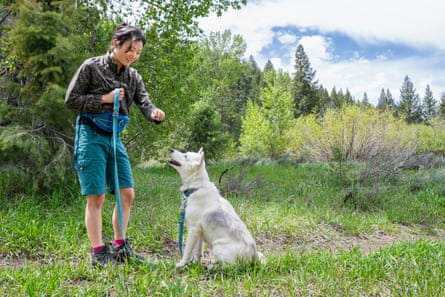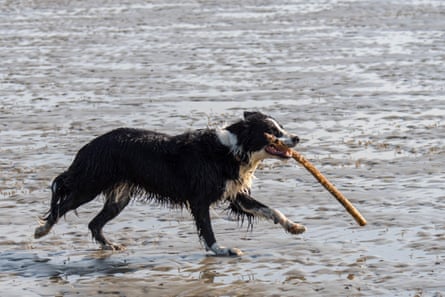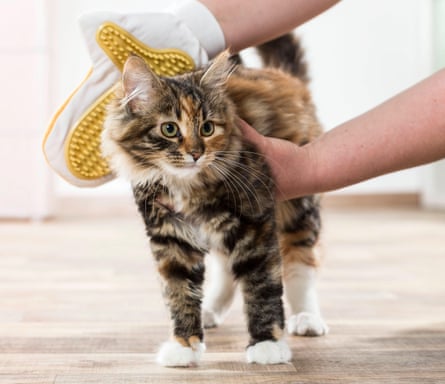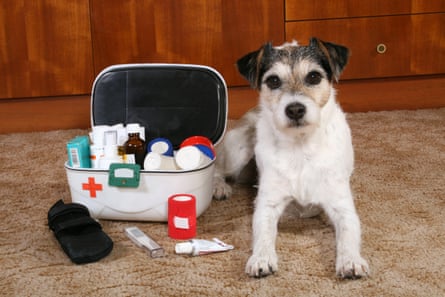Half of UK adults own a pet, with 28% opting for a dog and 24% a cat, according to vet charity PDSA. How can we ensure these animals are in good health? From feeding to fireworks, vets share their advice on how to keep our canine and feline friends healthy and happy.
Do your research
Rory Cowlam is a vet for Pickles in Fulham, London. He advises educating yourself before introducing a dog or cat into your home: “I would 100% recommend reading some books and looking online. There are so many good resources out there. Make sure you are getting the information from a reputable source: speak to vets, trainers, friends who have had pets, and build your knowledge base that way.”
Where you get your pet from matters too, says Cowlam. “The best thing to do is adopt from a charity. But if you’re going to a breeder, go on personal recommendations, or check for approved breeders – make sure to do your homework and at the first sign of something not quite right, move on.”
Feed them well …

“You don’t need the most premium thing on the market – just make sure you’re feeding them a good diet,” says Cowlam. He suggests looking at the ingredients on the back of pet-food packets and taking the contents as seriously as you might for yourself. Jo Lewis, a feline vet from Berkshire and author of What’s My Cat Thinking? says: “It is really important that people look at the label to see, is it ‘complete and balanced’? If it says ‘complementary’, it has not got all the right vitamins and minerals. If you just feed them that, they could end up with deficiencies.”
… But not too much
“There are studies to show that it can take two years off dogs’ lives if they are overweight,” says vet Cat Henstridge, who runs a practice in Dronfield near Sheffield. “For both species, it impacts negatively on their health: it predisposes cats to diabetes, it can complicate things such as heart disease. Dogs are born to run around, and if they are too big, this can be more difficult. So keep them slim. That is not always that easy, because they love to eat, we love to feed them, and it can be very hard to know whether they are too big or not. If you are ever worried, ask your vet: the doors are always open, the scales are always on.”
Lewis says puzzle feeders can “slow their eating down, but more importantly, it gives them something to do. It makes food not just inhaling biscuits from a bowl, it makes it an activity.”

Go easy on the treats
Treating your pet is a joy, but they should be given in moderation, says Cowlam. One of the traps people fall into is they give their dog treats that fill them up, then they don’t eat their dinner.” But treats can be key for training, Henstridge acknowledges: “They are a really good training tool if you’ve got a food-oriented animal. But it is easy to overfeed them because they don’t tell us when they’ve had enough. It is about making sure you know what your pet’s daily calories are, and then making sure you balance that out with meals and their treats.” You can also use other things to train and distract, such as toys and attention, she says.
Be cautious with fresh food
Including a bit of fresh food into their diet is OK, says Cowlam, but as a rough rule 50% should be a complete, balanced dog or cat food. On top of this, “you want to be adding things that are going to be beneficial, like vegetables or plain, lean protein.”
Cowlam adds: “If you are going to make your own [pet] food, in a word, don’t, because you won’t manage to balance it. You won’t manage to make it appropriate for them, it won’t be complete, and you run the risk of nutritional deficiencies.”
Know what foods are toxic
“There is a bit of crossover between cats and dogs on the toxin side,” says Cowlam. “Both of them are a big no on grapes, raisins and chocolate. Onions, leeks and garlic are worse for cats than dogs, but still quite bad for both, and dose dependent. And xylitol, a sweetener in things like confectionery and peanut butter – do keep an eye out for it.” He says that Christmas and Easter are big times for poison-related vet visits because “raisins are everywhere”.
Clean their teeth

“Dental health is often cited by vets as one of the top welfare concerns in pets, and we are very good at turning a blind eye to that,” says Cowlam. “It is very rare that I see an animal get to double figures without needing some sort of dentistry.” It is integral to establish a brushing routine from day one, the vets agree, to get the animal used to doing it as early as possible.
“You can teach an old dog new tricks, and even cats can be persuaded,” says Henstridge, “but it isn’t easy, and it is a real skill as well, to handle a brush and a dog and some toothpaste.” Finger brushes can work better, “because then you’re not coming at their face with a stick. The problem is, by the time you’re noticing bad breath, the teeth may well be painful, so the reason they don’t want you to do it is because it is sore”. It is worth getting “a proper dental assessment at a vet, having the dental work they recommend, then starting from a clean slate,” says Henstridge. If you can’t persuade pets to have their teeth brushed, there are products, such as teeth biscuits, chews or powders, she says: “but just do something”.
Ensure exercise is part of their routine

“Most dogs would benefit from an hour of exercise a day, but what is more important is what the exercise is,” says Henstridge. “If a dog can get off the lead, then they can do their own thing: potter, sniff and gallop a bit.” Dogs see the world through their noses, which gives them a lot of mental stimulation. “We want to physically tire them out so they can sleep, but we also want to mentally tire them out so when they get home they are in the frame of mind to rest, rather than parkour off the sofa.”
“Exercise is probably more of a problem in cats,” says Cowlam, “because cats are inherently sedentary, particularly indoor cats.” Allocating play time with them, like you would walking for a dog, is essential, he says. “If you can safely give cats access to outdoor space, then that is the goal,” says Lewis. “But the reality is, a lot of cats have never been outside. That means we have to provide everything they would be getting from an outdoor life as much as we can inside.” Cat trees, multilayered structures and shelves with grip on them can provide this.
Ditch the ball flinger
Henstridge has an impassioned plea for dog owners: “If you have a ball flinger, throw it in the bin and never use it. They are the worst because the dogs go super far, really fast. They jump and leap for the balls. The balls bounce up and down, and then they turn on a sixpence and hare back. It is really intense exercise on their joints, which over time can be incredibly damaging. Some dogs develop addict-type behaviour towards balls, because of the adrenaline rush they get when they’re doing this, and that is no good for their mental health.”
Some pets don’t like to be left alone
“You need a degree of separation from your pet from day one,” says Cowlam, otherwise “you’ll end up with a dog that needs to be in sight of you at all times.” When leaving them, start small from 10 minutes and build up. Four hours is the maximum that the RSPCA recommends leaving a dog for. “I probably wouldn’t want to do that too frequently,” says Cowlam. “I can probably count on one hand how many times I’ve left my dog for four hours, and she is five.”
If they’re scared of bangs try drum’n’bass
It is the season for banging fireworks that can frighten pets. “The main species that struggles is dogs,” says Henstridge. “That’s not to say that cats don’t, but they are less demonstrative about their fear. If your cat goes and hides, leave them to it.” She advises locking any cat flaps, though, as they can get disoriented by the noise and go missing if they go out.
With dogs, Henstridge advises to “give them a good run around on the days when you know there will be fireworks. Tire them out, feed them their tea early – because a tired, full dog is a sleepy dog. Give them a toy to distract them: chewing and licking is an anxiety-dumping behaviour for dogs. Shut the curtains, turn on the telly: dogs have very sensitive hearing, so they will probably still hear the bangs, but drowning out the night with something else is really helpful. The best way to do that, if they are very sensitive, is actually drum’n’bass music, because of the rhythm, and the bangs in the music.”
Care for their hair

“Nobody wants to bath a dog unless they absolutely have to,” says Henstridge. Luckily, “you shouldn’t need to regularly unless they have a skin problem. Some sensitive dogs with allergies benefit from regular medicated baths, but the average dog does not. It is very dependent on when they roll in something disgusting, possibly more frequently for the fluffy ones.”
With cats, “if they are fit, well and they are shorthaired, they probably don’t need to be brushed,” says Lewis, “however, like tooth brushing, you don’t want to wait until there’s a problem and then try to start to teach them how to tolerate being groomed”. Lewis suggests using, “silicone hand-shaped brushes that are like a massage tool that feels nice, not tugging or sharp and bristly. That can be a great way of enriching time with your cat.” Remember to remove any loosened hair with damp hands or rubber gloves to avoid hairballs, says Lewis.
Keep a basic animal first aid kit

Try to gauge the severity of an injury before contacting your vet, says Cowlam: “There are some things you can give a little bit of time, like cuts and scrapes. If it’s not that deep, keep it clean, cover it, don’t let them lick it. Having a first aid kit at home is really sensible, with pet-safe antiseptic spray for cuts, scrapes or torn nails, and some sort of bandaging material. With limping, “as long as the pet seems OK, is eating and drinking well, give it 24 hours or so, because a lot of these problems will settle with a bit of rest and recuperation. There are a lot of really good services out there that provide veterinary care over apps and text, if you are more of a worried owner and you want that level of communication without coming into the vet.”
If you are ever in doubt, seek help, says Henstridge: “Our animals are really good at hiding things and coping with illness and pain – they won’t necessarily limp, cry or squeal, they will just slow down a bit.”
Have regular checkups
“Have a relationship with your local vets,” says Henstridge. “Take pets for their annual vaccines, regular checkups, because having that professional assessment of their health is so valuable.”
How often should you visit? “If you’ve got a generally healthy pet, once a year is fine for a health check,” says Cowlam. Go armed with a list of questions: “I love it when people come with a list, because it gives me some structure to work on while I’m examining the pet.”
“If the cat is going outside, then it will have the potential to be exposed to all sorts of ticks, fleas and worms,” says Lewis. “I would always suggest people talk to their vets about their cat and their own individual lifestyle to get a proper risk assessment as to what products and what frequency they need to be applied.”
Give them love

“You’ve got to think of pets as zoo animals,” says Lewis. As their owner, your job is to “enrich their life and take responsibility for what they are lacking.” That said, not all cats want to be stroked, Lewis points out: “Cats definitely need lots of the right sort of attention, but the caveat is that it should always be on the cat’s terms.” It is surprisingly overlooked, but above all, “love and attention is really important,” says Cowlam. “That is not only the best thing about having a pet, but it is also really important for them, so make sure you’ve got plenty of time to give them.”

 3 hours ago
6
3 hours ago
6

















































